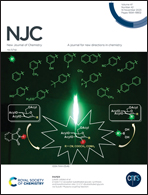A multimodal therapeutic nano-prodrug as an oxidative stress amplifier induces apoptosis and ferroptosis for cancer therapy†
Abstract
As genotypic and phenotypic mutations that enhance survivability are preserved during tumor evolution, some cancer cells tend to develop resistance to a particular programmed death, leading to the failure of cancer monotherapy. Fortunately, the combinational therapy of apoptosis and ferroptosis holds potential for addressing this tumor heterogeneity. Herein, a multifunctional free radical initiator was prepared by coating DHA-loaded mesoporous polydopamine (MPDA) nanospheres with Fe3+-tannic acid (TA) complexes and hyaluronic acid (HA) to achieve oxidative stress amplification and apoptosis/ferroptosis sensitization. This nanoplatform MPDA/DHA@Fe–TA@HA, denoted as MDTFH, was equipped with active targeting and tumor microenvironment (TME) activation, facilitating precise delivery and tumor-specific toxicity of chemotherapeutic agents, DHA. Upon exposure to the HAase-rich and acidic TME, the HA coating and Fe–TA networks would dissociate gradually, triggering the controlled release of Fe3+ and internal DHA. Subsequently, the Fe3+/Fe2+ conversion driven by glutathione (GSH) depletion would catalyze the Fenton reaction and DHA toxification to produce ˙OH and ˙C, that is, chemodynamic therapy (CDT) and chemotherapy (CT) were activated, respectively. Moreover, the superior photothermal therapy (PTT) effect stimulated by NIR irradiation could improve the efficacy of CDT and CT, which together with hyperthermia-induced tumor sensitivity intensify oxidative stress and lipid peroxidation, thus leading to apoptosis and ferroptosis. It was demonstrated in a 4T1 tumor-bearing mice model that MDTFH can significantly inhibit tumor growth through synergistic PTT/CT/CDT effects. Overall, this work provides a feasible paradigm to design multimodal therapeutic strategies inducing ferroptosis and apoptosis for cancer precision therapy.



 Please wait while we load your content...
Please wait while we load your content...